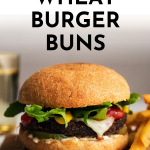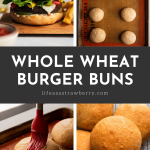Description
These easy homemade whole wheat hamburger buns are perfect for summer grilling!
Ingredients
For the dough:
- 9 grams active dry yeast (2 1/4 teaspoons, or 1 packet)
- 12 grams honey (1 Tablespoon)
- 240 grams warm water (about 1 cup)
- 200g All-Purpose Flour (about 1 2/3 cups)
- 200g Whole Wheat Flour (about 1 1/2 cups)
- 9 grams kosher salt (about 1 1/2 teaspoons)
- 1 large egg, lightly beaten
- 2 Tablespoons unsalted butter, melted
For baking:
- 2 Tablespoons unsalted butter, melted
- 2 Tablespoons sesame seeds (optional, for topping)
Instructions
MIX THE DOUGH AND FIRST RISE (1 HOUR)
- Stir yeast, honey, and warm water together in a large mixing bowl (you could also use a stand mixer fitted with a dough hook). Let stand for 5 minutes until the yeast is active and the mixture is foamy.
- Add all purpose flour, whole wheat flour, kosher salt, egg, and melted butter to the yeast mixture. Use a wooden spoon or a sturdy spatula to stir everything together until no dry bits of flour remain. If it gets tough to stir the dough with a spoon, use clean hands to knead the dough together until it’s well mixed.
Note: You can continue to knead this dough by hand (5-10 minutes) or with the dough hook on a stand mixer (3-5 minutes) until it’s smooth and elastic if you like; this will develop more gluten for a smoother dough and a bit more chew. If you’re short on time or just don’t feel like putting in that much elbow grease, just mix the dough until no dry bits of flour remain (it’s ok if it’s still a little shaggy and sticky!) We have tested this recipe with and without additional kneading and it’s good either way, so feel free to adjust based on your personal preference! In the photos above, we mixed the dough until it was just combined (with no additional kneading).
- When dough is mixed, cover the bowl with a clean tea towel and let dough rise at room temperature for one hour, until it’s about doubled in size.
SHAPE THE DOUGH & FINAL RISE (30 MINUTES)
- When dough has risen, tip it out onto a lightly floured cutting board.
Tip: If the dough is sticking to the sides of the mixing bowl, run your hand under cold water to prevent sticking as you pull the dough out.
- Knead the dough a few times to work out any large air pockets, then pull the dough into a round shape (this makes it easier to divide).
- Use a bench scraper or a knife to divide the dough into 8 evenly sized pieces.
- Add more flour to your cutting board if you need it, then shape each piece of dough into a ball. To shape, pull the corners of each dough piece in towards its center, then pinch the edges together and roll the dough across the cutting board to form a round shape.
- Place the dough balls on a baking sheet lined with a nonstick baking mat, leaving 2 inches between each piece.
- Gently press down on each ball to flatten it about halfway. Cover shaped buns with a clean tea towel and let rest for another 30 minutes while you heat the oven.
- Heat the oven to 375° Fahrenheit.
BAKE (15-18 MINUTES) & COOL (30-60 MINUTES)
- When the oven is hot, use a pastry brush to brush each burger bun with a bit of melted butter. Top with a sprinkle of sesame seeds (optional).
- Bake at 375° F for 15-18 minutes until golden brown.
- Remove buns to a wire cooling rack. Let cool completely (for at least 30 minutes) before slicing and serving. Note: These buns might feel a little stiff right when you take them out of the oven; the crust will soften as they cool.
Notes
What kind of flour should I use? We always recommend using King Arthur Flour when baking. They're incredibly consistent from bag to bag, and King Arthur All Purpose flour has a high protein content (which means better gluten development, which means the dough is easier to work with). Bob's Red Mill flours are also a good option for baking.
Substitutions. Use sugar, brown sugar, or molasses instead of honey. Use bread flour in place of some or all of the other flours in this recipe. Use additional all purpose flour in place of some or all of the wheat flour if you like. We do not recommend increasing the amount of whole wheat flour in this recipe (see the FAQ above or our Everyday Artisan Bread course for more on flour substitutions!)
How warm should my “warm water” be? A good rule of thumb is “warm to the touch.” Too-hot water (typically 130-140 degrees F and above) will kill your yeast, but use too-cold water and your yeast will take too long to activate. We usually shoot for a water temperature between 95° and 110° Fahrenheit. You should be able to comfortably hold your hand under water running at about 100 degrees – it should feel quite warm, but not hot. Use a kitchen thermometer for a precise measurement if you like!
Please use a kitchen scale if you can! Measuring by weight with a kitchen scale is much more accurate than measuring by volume (with cups). Because each person measures a cup of flour a little bit differently, it's easy to end up using way too much flour in a recipe - which results in dry, dense bread! When you measure your flour in grams with a kitchen scale, you can measure flour perfectly every time.
Mix this dough by hand OR with a stand mixer - it works well either way! If you use a stand mixer, fit it with the dough hook and add the flour a little bit at a time to ensure the mixer incorporates everything evenly. Let the mixer run an additional 3-5 minutes once all the flour is incorporated to develop the gluten in the dough more fully for a stronger, smoother dough.
Adjusting the rise time. If your kitchen is especially chilly, you may need to let the dough sit another 15-30 minutes during the first rise.
Adding toppings and mix-ins. Right after you brush the buns with melted butter, sprinkle on some sesame seeds, flakey sea salt, shredded cheese, or fresh herbs. You can also add mix-ins like roasted garlic, fresh herbs, or shredded cheese directly to the dough when you first mix it.
Adjusting the size of your burger buns. Cut your dough into 8 pieces for standard-sized burger buns, 10 pieces for small burger/large slider buns, or 12 pieces for small slider buns. If you make smaller sized rolls, you will need to adjust the cook time (for small buns, start checking for doneness at about the 8-10 minute mark). We have also used this dough for hoagie/sub rolls.
For more ideas and instructions about flour types, dough shapes, and other substitutions and techniques, be sure to enroll in our Everyday Artisan Bread course.
Serve these buns with your favorite burger recipe! We love using homemade hamburger buns with our Smoked Gouda Beer Burgers, Easy Salmon Burgers, or Black Bean Burgers.


